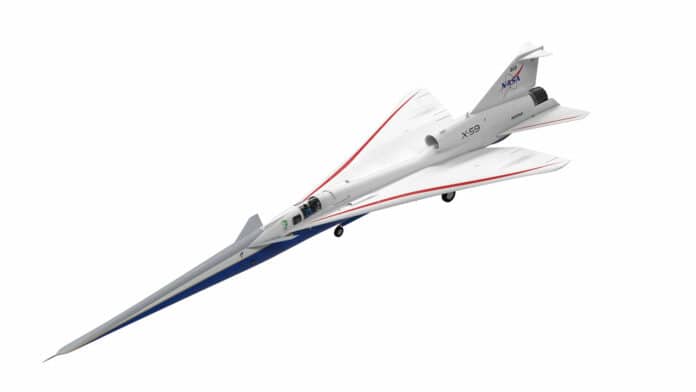NASA’s X-59 quiet supersonic aircraft continues to make progress, most recently moving to the paint barn at Lockheed Martin Skunk Works’ facility in Palmdale, California.
The aircraft will be painted with a mainly white body, a NASA “sonic blue” underside, and red accents on the wings. The paint not only adds cosmetic value but also protects the aircraft from moisture and corrosion, and the design also features key safety markings that will assist with ground and flight operations.
NASA’s X-59 plane, the centerpiece of NASA’s Quesst mission, was moved to the paint barn on Nov. 14, 2023. After painting, the team will take final measurements of the aircraft’s weight and exact shape to improve computer modeling.
“We are incredibly excited to reach this step in the mission. When the X-59 emerges from the paint barn with fresh paint and livery, I expect the moment to take my breath away because I’ll see our vision coming to life,” said Cathy Bahm, the low boom flight demonstrator project manager. “The year ahead will be a big one for the X-59, and it will be thrilling for the outside of the aircraft to finally match the spectacular mission ahead.”
The X-59 is an experimental aircraft designed to fly faster than the speed of sound while reducing the noise when it breaks the sound barrier. The ground noise is expected to be around 60 dB(A), about 1/1000 as loud as current supersonic aircraft. This is achieved by using a long, narrow airframe and canards to keep the shock waves from coalescing. It should create a 75 Perceived Level decibel (PLdB) thump on the ground, as loud as closing a car door.
The X-59 will be 94 feet (29 meters) long with a 29.5 feet (9 meters) wingspan for a maximum takeoff weight of 32,300 lb (14,700 kg). Propelled by a General Electric F414 engine, it is designed to fly at 55,000 feet (16,800 meters) at a cruise speed of Mach 1.42 (940 mph/1,510 km/h) – nearly twice the speed of a standard passenger jet. It should reach a maximum speed of Mach 1.5 or 990 mph (1,590 km/h). Such high speeds will dramatically reduce flight times between destinations.
NASA will fly the X-59 over several selected U.S. communities and gather data about people’s perceptions of the sound it makes. If the X-59 program is successful, it could potentially revolutionize regulations that currently restrict the flight of supersonic jets over land.
